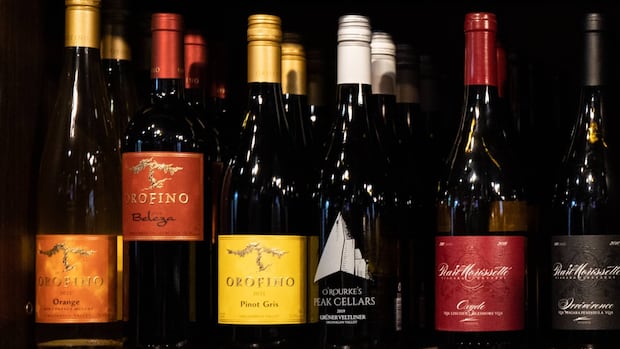Canned cocktail hitting you hard? As ready-to-drink cans grow in popularity, some are getting stronger

If you've ever put back a can of Cutwater, and only then realized how much booze is in it, TikTok would like to remind you that you're not alone.
Consumers have been sharing their stories — and surprise — about how strong the canned cocktails are on social media.
"One can, I'm drunk," one Canadian user posted on TikTok. "Suddenly we have this one option at the liquor stores that just gets you wasted."
Another user said the effects of one can felt like taking multiple shots.
While they come in a standard, 355-millilitre can, some flavours of the drinks pack a far bigger punch than a standard beer, with an alcohol percentage of 12.5 per cent listed on the packaging.
But Cutwater is far from the only brand making high alcohol-by-volume (or ABV) products — Dillon's and Founder's are among the brands also selling canned cocktails at 12.5 per cent, while Mike's Hard, White Claw, Twisted Tea and more all make higher alcohol versions of their original products.

Ready-to-drink beverages (or RTDs) — pre-made cocktails, hard seltzers or anything else that comes ready to consume that isn't wine or beer — have seen a boom in recent years. The Liquor Control Board of Ontario (LCBO) says that ready-to-drink beverages are one of the fastest growing categories in recent years, with sales increasing by 9.5 per cent to $745.1 million total in 2024 alone. And Canada-wide, the ciders, coolers and ready-to-drink category together amassed about $2.29 billion in sales in 2023-24, according to Statistics Canada — more than double what it was in 2018-2019.
Alongside that popularity, the market for higher alcohol percentage has also grown, according to industry experts. But with all the new varieties of RTDs available, consumers might not be accustomed to — or even aware — of the amount of booze they're getting.
Demand for higher ABVAndrew Ferguson, owner of Kensington Wine Market in Calgary, says the demand for stronger drinks has led to the rise of boozier pre-made cocktails.
"People want things that are maybe twice as strong as your average RTD, and so that's why they're bottling them at 10 per cent or 11 per cent," Ferguson said. "Now, whether [all] people are noticing that or not is a whole other matter."

Ferguson says he expects folks are used to most cans having five per cent alcohol. "The average consumer is probably just assuming [all cans are] gonna be about the same, and so there won't be that much difference," Ferguson said.
And even if they do see the number on the front, they might not fully know what that per cent means for them, says Marten Lodewijks, president for the North American wing of alcohol industry research group IWSR.
"Everyone knows seven is bigger than five, and 10 is bigger than seven. So mathematically that lands," Lodewijks said. "But how strong is seven per cent? How strong is 10 per cent? How strong is five per cent? That's not something that is typically well understood by consumers."
Marketing of cans is shifting — so read them carefullyWhen it comes to higher alcohol percentage drinks, Lodewijks says there's a bang-for-your-buck factor — cans at a standard five per cent are often priced the same as those that are seven, 10 or even 13 per cent.
"So if I am feeling a bit financially constrained, then you're going to opt for that better value-for-money proposition. And we're definitely seeing a lot of skew in that direction," Lodewijks said.
While high alcohol drinks have always existed, the marketing of them has shifted as the product category has grown, according to Lodewijks.
"Traditionally the high ABV products, they kind of often would make you look like an alcoholic. There'd be very large cans that had fairly aggressive names, and it was quite clear what the purpose of them was," Lodewijks said.
But within the past few years, he says that's changed — while there's some outliers, high ABV products might look like any other can on the shelf, Lodewijks says.

Markus Giesler, a marketing professor at York University's Schulich School of Business, agrees.
The marketing and packaging of many high ABV drinks use words like "water," he says, or imagery we'd associate with soft drinks — "drinks that we might associate with quenching our thirst but not necessarily getting drunk."
Beyond that, many brands now have a higher percentage version of their original drink — like White Claw, which makes a seven per cent version of their hard seltzers, while the original drink was only five per cent. Giesler says that difference might be hard to miss, especially if shoppers are in a rush, or picking up a few cans quickly on their way to a party.
Because brands are changing their marketing so much in an effort to make their ready-to-drink product stand out, marketing professor Marvin Ryder says consumers can't rely on the idea that a single can is a way to measure how much you're drinking.
The best antidote to an embarrassing night, he says, is to read the ABV labels on cans before you crack them.
"Don't get sucked in by pretty colours or pretty brand names," Ryder said. "Read, be an educated consumer — understand what you're getting in each of these different products, and then have fun."
cbc.ca





